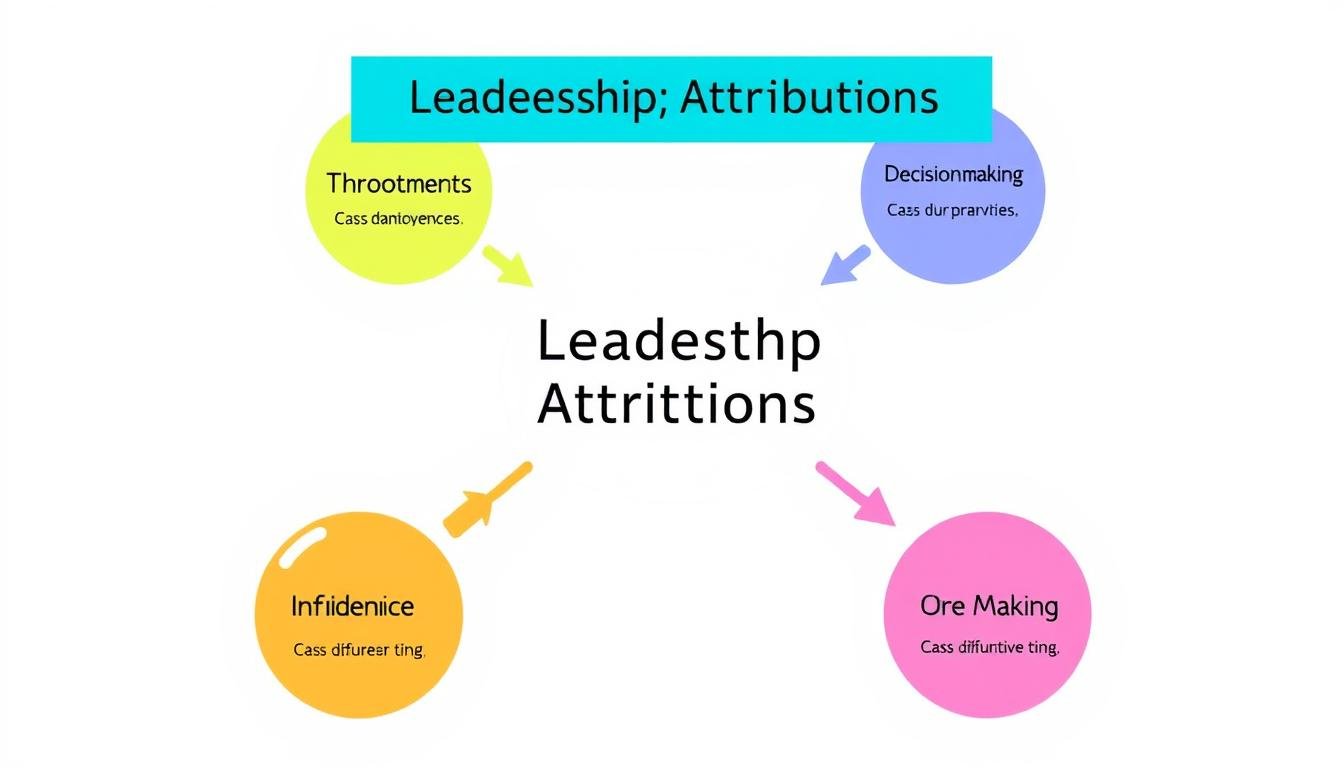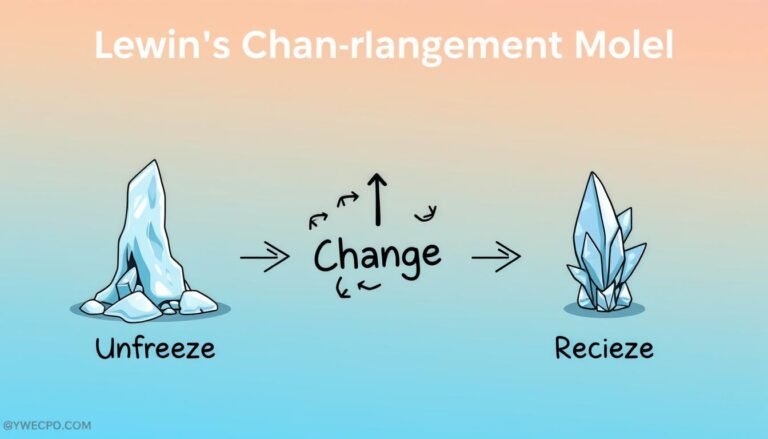Attribution Theory in Leadership
In leadership, knowing why people act a certain way is key. Attribution theory helps leaders understand behavior and performance. It guides their decisions and how they interact with others.
Attribution theory looks at why we see things a certain way. It’s about the ‘why’ behind our views of leader success. When a team does well or not, a leader’s view of this can change future plans.
Leaders use this theory to judge their team’s work. They figure out if success comes from the employee’s skills or luck. These views shape how leaders react to different situations.
Knowing attribution theory helps leaders make better judgments. It helps them see the difference between personal and outside factors. This is crucial for fair judgments and good leadership plans.
Key Takeaways
- Attribution theory explains how leaders interpret behavior and form judgments
- Leaders use internal and external attributions to assess performance
- Understanding attributions improves leader effectiveness
- Accurate causal explanations lead to better leadership decisions
- Attribution theory impacts how leaders evaluate and respond to team outcomes
Understanding the Foundations of Attribution Theory
Attribution theory comes from social psychology and is key in understanding how we see others’ actions. It helps us understand how we judge others based on what happens.
Origins and Historical Development
Fritz Heider first talked about attribution theory in 1958. It became more important in the 1980s. This theory helps us see how we make sense of events and people’s actions.
Key Contributors
Many scholars built on Heider’s ideas:
- Fritz Heider: Started it all in 1958
- Edward Jones and Keith Davis: Added to it in 1965
- Harold Kelley: Made a big contribution in 1967
Basic Principles and Concepts
Attribution theory in leadership has three main steps:
- Perception: Seeing what happens
- Judgment: Figuring out why it happened
- Attribution: Saying what caused it
Leaders use these steps to understand their team. It helps them make better decisions. It also shows how leaders see their team, affecting motivation and performance.
| Attribution Type | Example | Impact on Leadership |
|---|---|---|
| Internal | Lack of interest from followers | May lead to corrective actions focused on motivation |
| External | Equipment breakdown | May result in process improvements or resource allocation |
Knowing these basics is key to using attribution theory. It helps leaders do better and improve how teams work together.
Attribution Theory in Leadership
Attribution theory is key to understanding leadership. It shows how leaders see and react to their team’s work. This affects how well the team does. Let’s look at what makes up this theory.
Definition and Core Components
Leadership attributions are about figuring out why things happen in a team. It helps leaders understand their team’s work. They look at both inside and outside factors, and stable and unstable things that affect how well the team does.
Leadership Evaluation Models
Many models help us understand how leaders make attributions. The two-step model from 1979 says leaders first find out why things happen. Then, they decide what to do next. This helps them really get what’s going on with their team.
| Leadership Style | Organizational Fit | Key Characteristics |
|---|---|---|
| Attribution-based | Stable organizations | Cause-and-effect oriented, high-performance standards |
| Charismatic | Early-stage or challenged organizations | Self-sacrifice, goal-oriented, crisis management |
| CIP Model | Various organizational contexts | Combines charismatic, ideological, and pragmatic approaches |
Behavioral Interpretation Process
Leaders go through a complex process to understand their team’s performance. They watch for signs, think about the situation, and judge why things went well or not. Studies show most people blame either inside or outside reasons for things. This shows how crucial it is for leaders to grasp this process.
Internal vs External Attribution Factors
Leaders must understand what drives their team’s success. They need to know the difference between internal and external factors. These elements are key in making decisions and shaping team dynamics.
Understanding Internal Attributions
Internal attributions deal with personal traits and choices. They include skills, effort, and motivation. Leaders often see success as a result of these personal qualities.
For example, they might say a project’s success is because of a team member’s hard work and skills.
Exploring External Attributions
External attributions are outside an individual’s control. They include things like equipment failures, tight deadlines, or market changes. Leaders look at these when judging performance.
A missed deadline might be due to a supply chain problem, not lack of effort by the team.
Impact on Leadership Decisions
Leaders’ views on success or failure guide their choices. If they see failure as a personal issue, they might choose training or coaching. But if they see it as outside their control, they might change processes or resources.
Leaders who balance these views create a fair and productive work environment.
| Attribution Type | Example | Potential Leadership Response |
|---|---|---|
| Internal | Lack of skill | Provide training |
| External | Equipment failure | Upgrade resources |
| Internal | High motivation | Offer promotion |
| External | Market downturn | Adjust targets |
Knowing these attribution factors helps leaders make better decisions. This leads to a balanced and effective leadership style.
The Role of Perception in Leadership Attribution
Leadership perception shapes how managers see employee behavior and make choices. This process, called attribution, greatly affects work life. It’s key to a good work place and better team work.
Studies reveal leaders often have biased views on employee actions. For example, they might think too highly of themselves and not enough of their team. This can lead to unfair judgments and missed chances for growth.
Leaders might also think their views are more common than they really are. This can cause misunderstandings and wrong expectations between managers and workers.
“Perception is how a person interprets information around them; it affects personality traits, responses to situations, task performance, and creativity in organizational behavior.”
To be better leaders, managers need to know about these biases. They should aim to be fair in their judgments. By understanding how perception affects attribution, leaders can make better choices. This helps create a supportive work place where everyone can grow and do well.
Leadership Decision-Making Through Attribution Lens
Leaders use attribution theory to guide their decisions. This helps them understand why employees perform well or not. It shapes their expectations for the future.
Causal Analysis in Leadership
Causal analysis is key in leadership decisions. Leaders look at both internal and external factors to find the reasons behind employee actions. This approach, based on Fritz Heider’s 1958 work, helps leaders make better choices for their team.
Performance Assessment Framework
Understanding attribution theory is crucial for fair performance assessments. Harold Kelley’s model shows how to link cause and effect. Leaders use this to judge employee performance accurately.
Attribution-Based Interventions
Leaders can design specific interventions based on attribution theory. By knowing how employees attribute success or failure, leaders can motivate them better. This approach, based on Rotter’s 1975 findings, shows that attributions can change over time.
However, leaders must be careful with attribution theory. Wrong judgments about performance can lead to bad decisions. By considering both cognitive and affective aspects of conflict, leaders can make better decisions. This leads to a more productive work environment.
Impact of Attribution on Employee Performance
Attribution theory is key in shaping how employees perform and feel motivated. Leaders’ views on employee actions greatly shape the workplace. Studies show leaders’ influence goes beyond making decisions. It affects how employees see their skills and growth chances.
When leaders blame poor performance on the employee, it can lead to negative feedback or punishment. This can lower motivation and stop performance from getting better. But, when leaders credit success to the employee, it boosts morale and leads to better results.
A study on leader self-sacrifice behavior found some interesting things:
- When employees see leaders as authentic, they trust them more and perform better.
- Seeing leaders as hypocritical can make employees less likely to help out.
- Feeling positive about leaders’ self-sacrifice can make employees more engaged and perform better.
This study challenges the idea that leaders’ self-sacrifice always helps. It shows the importance of understanding how employees see leadership actions. This is crucial for motivating and improving performance.
Knowing about attribution theory’s three main parts – locus of control, stability, and controllability – helps leaders. By tackling biases and stereotypes, leaders can make the workplace more efficient. This leads to better and lasting performance improvement.
Organizational Behavior and Attribution Theory
Attribution theory is crucial in understanding how people behave at work. It shapes how teams work together and perform. It helps us understand how we interpret events and judge why people behave a certain way.
Workplace Dynamics
In the workplace, attribution theory changes how employees and leaders interact. People try to explain their actions and those of others. This affects their attitudes and behaviors at work.
Team Performance Attribution
Team success or failure is greatly influenced by how team members attribute it. When a team wins, they might say it’s because of their skills or luck. These beliefs can shape their future performance and motivation.
Organizational Culture Impact
The culture of an organization influences how people attribute success or failure. Some cultures value personal responsibility, while others look at external factors. This affects decision-making and overall success.
| Attribution Type | Impact on Workplace Culture |
|---|---|
| Internal | Encourages personal responsibility |
| External | Focuses on situational factors |
Knowing about attribution theory can help leaders improve team dynamics and create a better work culture. By understanding how attributions influence behavior, organizations can find ways to boost performance and employee happiness.
Common Attribution Biases in Leadership
Leaders often struggle with decision-making because of attribution biases. These biases can really affect how well they lead and make mistakes. It’s key to know about these biases to get better at leading and improve results.
Self-Serving Bias
The self-serving bias is a big problem for leaders. It’s when they take credit for wins but blame others for losses. This can hurt work performance and motivation.
Leaders with this bias might praise themselves for successes but ignore their part in failures.
Fundamental Attribution Error
This bias makes leaders judge others based on character, not situations. It can lead to unfair treatment at work. It’s hard to overcome, but awareness and emotional smarts can help.
Actor-Observer Bias
The actor-observer bias makes leaders judge themselves differently than others. This can mess up how they see their team’s skills. It can also affect how well the team works together.
| Attribution Bias | Impact on Leadership | Mitigation Strategy |
|---|---|---|
| Self-Serving Bias | Decreased team morale, skewed self-perception | Practice self-reflection and seek feedback |
| Fundamental Attribution Error | Unfair judgments, strained relationships | Consider situational factors, practice empathy |
| Actor-Observer Bias | Inaccurate performance evaluations | Gather multiple perspectives, avoid snap judgments |
Knowing about these biases is the first step to better leadership. By tackling these biases, leaders can make smarter choices and create a better work place.
Attribution Theory Application in Modern Leadership
Today’s leadership is changing, with attribution theory at its core. Leaders who grasp this theory can improve their skills and success.
Attribution-based management is gaining traction in workplaces. It helps leaders tackle tough issues and give better feedback. By focusing on what they can control, leaders can overcome obstacles and create strong teams.
Matt Wallat, a District Ranger with the National Park Service, is a great example. With 20 years of experience, he excels in training and developing employees. His work in Tanzania shows how attribution theory boosts leadership in different places.
Adding attribution theory to leadership training is key. It helps leaders make fair judgments about their team’s work. This way, leaders can manage their emotions better and achieve more. Using attribution theory, companies can also boost their team’s motivation and performance.
- Leaders use attribution insights to improve communication
- Attribution-based management helps address complex challenges
- Understanding attribution theory leads to fairer performance evaluations
- Positive motivational strategies based on attribution theory are more effective
As leadership evolves, attribution theory will keep being a crucial tool. It helps create leaders who are empathetic and successful in many fields.
Conclusion
Attribution theory is key in leadership. It was first introduced by Fritz Heider in the 1950s. This theory helps us understand human behavior, especially in work settings.
Leaders who understand attribution theory can lead better. They know how to make their team work well together. This leads to success in the organization.
Studies show that knowing attribution theory matters a lot. For example, a study found that how leaders communicate affects teamwork. Leaders who support work-life balance can make their team better.
Attribution theory is important in many fields. In marketing, it helps understand customer value. In public service, it makes leaders more effective and keeps employees happy.
Using attribution theory, leaders can make their workplace better. They can make decisions more wisely and improve how the organization works. As businesses grow, attribution theory will keep being important for good leadership.
Source Links
- Attribution Theory – Explained
- Attribution Theory: Definition & Psychology
- Attribution Theory in Leadership Research
- TechnoFunc – Attribution Theory of Leadership
- Role of Attribution Theory in Explaining Employee Behaviour
- Charismatic and Attribution Leadership Comparison | Psychology Paper Example
- What is Attribution Theory? – iMotions
- 3.3: Attributions – Interpreting the Causes of Behavior
- The attribution theory in the workplace | Rod Matthews
- 3.4 Perception
- The Concepts of Perception And Attribution in Organizational Behavior in Business
- The Attribution Theory and its Organisational Application
- Conflict and Decision‐Making: Attributional and Emotional Influences
- Under the mask: The double-edged sword effect of leader self-sacrifice on employee work outcomes
- Workplace Behaviours: Attribution Theory & Strategies for Success
- Attribution Theory – (Organizational Behavior) – Vocab, Definition, Explanations | Fiveable
- Fundamental Attribution Error: What It Is & How to Avoid It
- All About Attribution Bias in the Workplace: 5 Types, Examples and Tips – Risely
- How to Make Attribution Work for You – GovLoop
- Stop Jumping to Conclusions: How Attribution Theory Can Transform Your Relationships
- ISSN: 2525-8761








